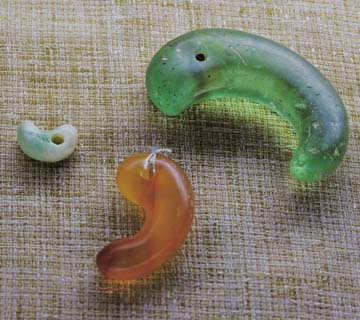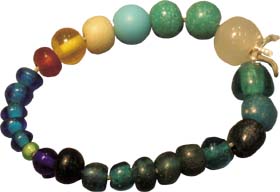
![]() Saturday, June 15 to Sunday, August 20, 2006
Saturday, June 15 to Sunday, August 20, 2006

| Rock Crystal Magatama (Comma-shaped Bead) Yayoi to Kofun period |
Glass Ring |

Kofun period

Glass Marudama (Round Beads)
Kofun to Tenpyô period
In the Heian period (794-1192), however, large works in glass were extremely few. For some reason-whether supplies of glass materials and products were relatively inaccessible after Japan broke diplomatic relations with the continent or whether the Japanese of the time did not care for glass as much-crystal came to be more prevalent. Nonetheless, glass, though less frequent, continued to decorate containers that held precious objects, such as reliquaries and sutra cases, and could be seen on lavish boxes and cases for imperial gifts in literary texts such as The Tale of Genji and The Tale of Lady Ochikubo.
 |
|
| Jadeite Magatama Yayoi to Kofun period |
Green Glass Magatama Yayoi to Kofun period |
| Agate Magatama Yayoi to Kofun period |
|
Finally, in the latter half of the Edo period (1615-1868), domestic glass production began to flourish. Glass items, based on the few examples of European and Chinese models, such as vidro (vitrified glass) wind-bells and vessels, that came into Japan through Nagasaki, the only foreign trade port of the time, started to be developed. In the 19th century, a refined, thick cut glass called giamant was introduced. The technique, in which angular cuts are made into color-coated glass, also came to be used, giving rise to distinctively Japanese designs, which incorporated a blurring effect. In time, the Japanese became familiar with this medium, and ultra-thin, delicate blown glass vessels, not seen in other countries, came to be made, attesting to the fine quality of Japanese glass during the Edo period. Glass producers appeared in printed books, and beautiful women holding transparent objects were depicted in woodblock prints.
